lock BMW Z8 CONVERTIBLE 2002 Owners Manual
[x] Cancel search | Manufacturer: BMW, Model Year: 2002, Model line: Z8 CONVERTIBLE, Model: BMW Z8 CONVERTIBLE 2002Pages: 174, PDF Size: 2.37 MB
Page 10 of 174

Contents
Overview
Controls and features
Cockpit16
Instrument cluster18
Indicator and warning lamps20
Hazard warning flashers24
Warning triangle24
First-aid kit24
Refueling25
Fuel quality26
Tire inflation pressure26
Locks and security systems:
Keys30
Electronic vehicle
immobilizer31
Central locking system32
Opening and closing Ð from the
outside32
Using the key32
Using the remote control33
Opening and closing Ð from the
inside36
Luggage compartment lid37
Alarm system38
Electric power windows40
The automatic convertible
top41
Adjustments:
Seats45
Steering wheel47
Mirrors47
Vehicle Memory, Key
Memory49
Passenger safety systems:
Safety belts50
Airbags51
Transporting children safely53
Driving:
Ignition and steering lock55
Starting the engine56
Switching off the engine57
Parking brake57
Manual transmission58
Turn signal indicator/Headlamp
flasher58
Washer/Wiper system59
Rear window defroster60
Cruise control61
Everything under control:
Odometer62
Tachometer62
Fuel gauge62
Coolant temperature gauge63
Service Interval Display63
Clock64
Multi-Information Radio (MIR)64
Technology for safety and
driving convenience:
Dynamic Stability Control
(DSC)65
Dynamic Performance
Control66
Flat Tire Monitor67
Contents
Page 11 of 174

11n
Controls and features
Operation, care and maintenance
Lamps:
Parking lamps/Low beams69
Instrument lighting69
High beams/Standing lamps70
Rear fog lamp70
Interior lamps71
Reading lamps71
Controlling the climate for
pleasant driving:
Heating and ventilation/
Air conditioner72
Seat heating77
Interior conveniences:
Glove compartment78
Storage compartments78
Beverage holder80
Cellular phone81
Ashtray81
Cigarette lighter82
Loading and transporting:
Cargo loading83
Special operating instructions:
Break-in procedures86
Driving notes87
Catalytic converter87
Antilock Brake System (ABS)88
Dynamic Brake Control
(DBC)90
Disc brakes90
Brake system92
Winter operation92
Power steering94
Cellular phone94
Car radio reception95
Wind deflector95
Hardtop96
Wheels and tires:
Tire inflation pressure99
Tire condition99
Tire replacement100
Tire rotation101
Wheel and tire
combinations102
Special features of winter
tires103
Snow chains103
Approved wheel and tire
specifications104
Under the hood:
Hood105
Engine compartment108
Washer fluids110
Washer nozzles110
Engine oil111
Coolant113
Brake fluid114
Vehicle Identification
Number115
Maintenance and care:
The BMW Maintenance
System116
Caring for your vehicle117
Airbags123
Vehicle storage124
Laws and regulations:
Technical modifications125
California Proposition 65
Warning125
OBD interface socket126
Page 17 of 174

17n
IndexDataTechnologyRepairsCar careControlsOverview
Cockpit
1
>
Turn signal indicator58
>
Standing lamps70
>
High beams70
>
Headlamp flasher58
2 Parking lamps/Low beams69
3 Washer/Wiper system59
4 Hazard warning flashers24
5 Central locking system32
6 Rear window defroster for the
hardtop60
7 Shift lever58
To engage reverse gear, pull the
lever across the gate to the left to
overcome the detent
8 Cruise control61
9 Adjusting the steering wheel47
10 Horn: entire surface
11 Rear fog lamp70
12 Unlocking the hood
13
>
Unlocking the luggage
compartment lid37
>
Unlocking the fuel filler door25
Page 19 of 174

19n
IndexDataTechnologyRepairsCar careControlsOverview
Instrument cluster
1 Fuel gauge with indicator lamp for
fuel reserve62
2 Speedometer with indicator and
warning lamps for
>
Dynamic Stability Control
(DSC)22
>
Engine electronics22
3 Instrument panel lighting69
4 Tachometer62
with indicator and warning lamps
for:
>
Battery charge current20
>
Convertible top operation41
>
Flat Tire Monitor20
>
Antilock Brake System (ABS)21
>
Parking brake/Brake hydraulic
system/Cornering Brake Control
(CBC)20
>
Service Engine Soon22
>
Engine oil pressure/Engine oil
level20, 21
5 Coolant temperature gauge with
"Coolant temperature too high"
warning lamp63
6 Indicator and warning lamps for:
>
Rear fog lamp22
>
Turn signal, right23
7 Clock648 Control button for:
>
Clock64
>
Trip odometer, reset to zero62
9 Indicator and warning lamps for:
>
Please fasten safety belts21
>
High beams23
>
Airbags21
10 Indicator for:
>
Odometer62
>
Trip odometer62
>
Service Interval63
11 Indicator and warning lamps for:
>
Turn signal, left23
>
Brake pads22
Page 21 of 174
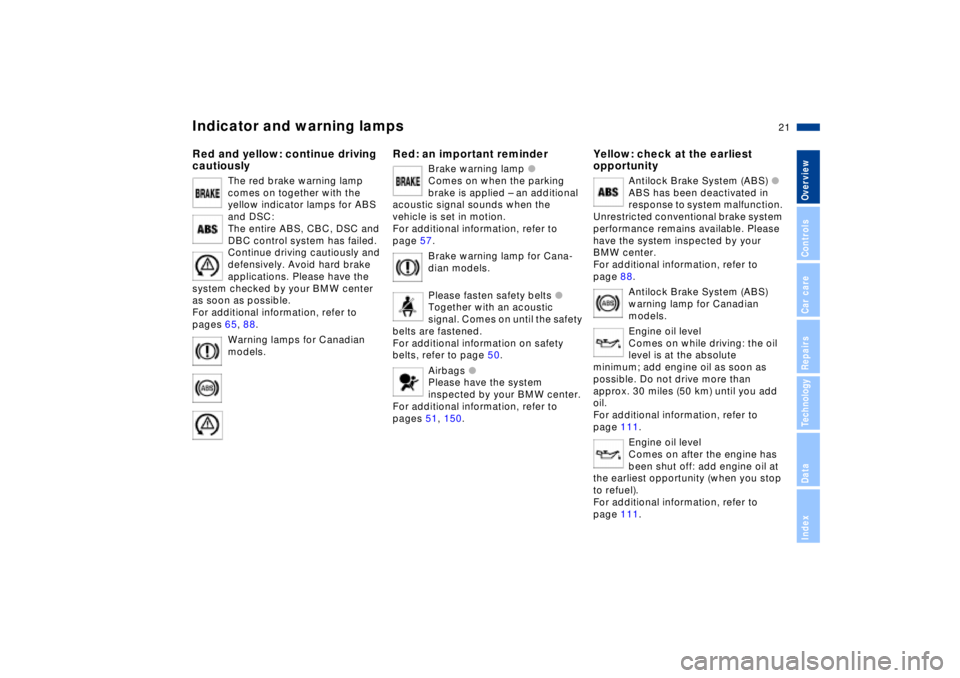
21n
IndexDataTechnologyRepairsCar careControlsOverview
Indicator and warning lamps
Red and yellow: continue driving
cautiously
The red brake warning lamp
comes on together with the
yellow indicator lamps for ABS
and DSC:
The entire ABS, CBC, DSC and
DBC control system has failed.
Continue driving cautiously and
defensively. Avoid hard brake
applications. Please have the
system checked by your BMW center
as soon as possible.
For additional information, refer to
pages 65, 88.
Warning lamps for Canadian
models.
Red: an important reminder
Brake warning lamp
l
Comes on when the parking
brake is applied Ð an additional
acoustic signal sounds when the
vehicle is set in motion.
For additional information, refer to
page 57.
Brake warning lamp for Cana-
dian models.
Please fasten safety belts
l
Together with an acoustic
signal. Comes on until the safety
belts are fastened.
For additional information on safety
belts, refer to page 50.
Airbags
l
Please have the system
inspected by your BMW center.
For additional information, refer to
pages 51, 150.
Yellow: check at the earliest
opportunity
Antilock Brake System (ABS)
l
ABS has been deactivated in
response to system malfunction.
Unrestricted conventional brake system
performance remains available. Please
have the system inspected by your
BMW center.
For additional information, refer to
page 88.
Antilock Brake System (ABS)
warning lamp for Canadian
models.
Engine oil level
Comes on while driving: the oil
level is at the absolute
minimum; add engine oil as soon as
possible. Do not drive more than
approx. 30 miles (50 km) until you add
oil.
For additional information, refer to
page 111.
Engine oil level
Comes on after the engine has
been shut off: add engine oil at
the earliest opportunity (when you stop
to refuel).
For additional information, refer to
page 111.
Page 25 of 174
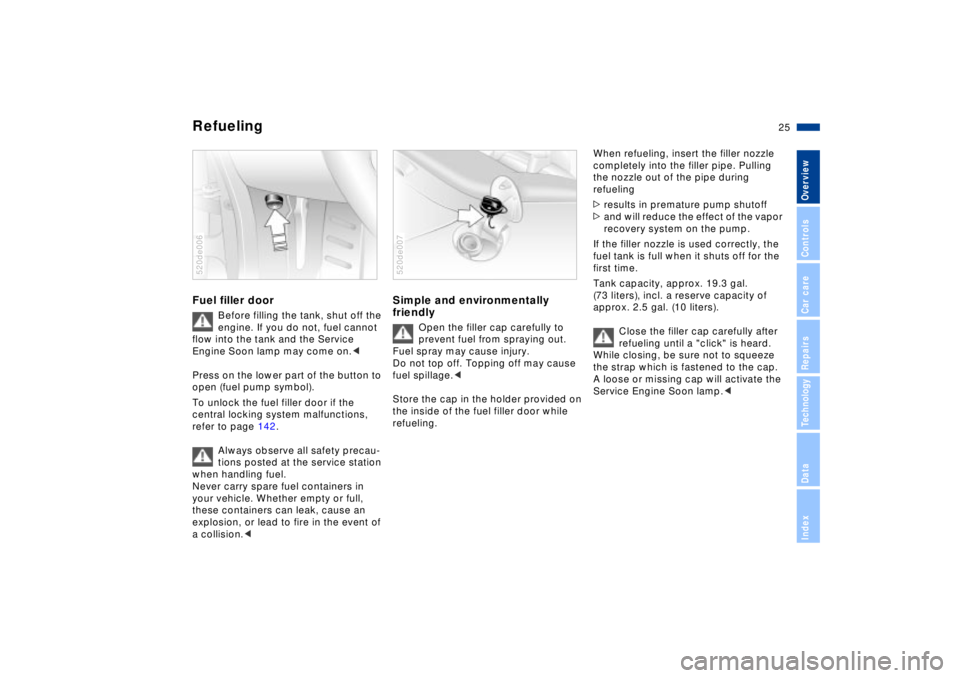
25n
IndexDataTechnologyRepairsCar careControlsOverview
Refueling Fuel filler door
Before filling the tank, shut off the
engine. If you do not, fuel cannot
flow into the tank and the Service
Engine Soon lamp may come on.<
Press on the lower part of the button to
open (fuel pump symbol).
To unlock the fuel filler door if the
central locking system malfunctions,
refer to page 142.
Always observe all safety precau-
tions posted at the service station
when handling fuel.
Never carry spare fuel containers in
your vehicle. Whether empty or full,
these containers can leak, cause an
explosion, or lead to fire in the event of
a collision.<
520de006
Simple and environmentally
friendly
Open the filler cap carefully to
prevent fuel from spraying out.
Fuel spray may cause injury.
Do not top off. Topping off may cause
fuel spillage.<
Store the cap in the holder provided on
the inside of the fuel filler door while
refueling.
520de007
When refueling, insert the filler nozzle
completely into the filler pipe. Pulling
the nozzle out of the pipe during
refueling
>results in premature pump shutoff
>and will reduce the effect of the vapor
recovery system on the pump.
If the filler nozzle is used correctly, the
fuel tank is full when it shuts off for the
first time.
Tank capacity, approx. 19.3 gal.
(73 liters), incl. a reserve capacity of
approx. 2.5 gal. (10 liters).
Close the filler cap carefully after
refueling until a "click" is heard.
While closing, be sure not to squeeze
the strap which is fastened to the cap.
A loose or missing cap will activate the
Service Engine Soon lamp.<
Page 28 of 174
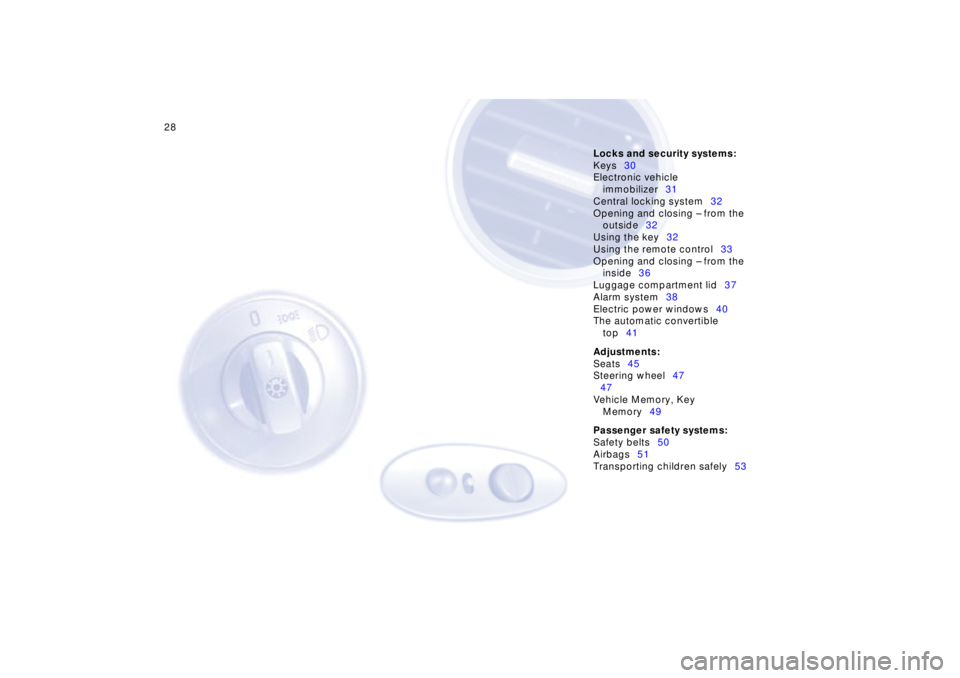
28n
Locks and security systems:
Keys30
Electronic vehicle
immobilizer31
Central locking system32
Opening and closing Ð from the
outside32
Using the key32
Using the remote control33
Opening and closing Ð from the
inside36
Luggage compartment lid37
Alarm system38
Electric power windows40
The automatic convertible
top41
Adjustments:
Seats45
Steering wheel47
47
Vehicle Memory, Key
Memory49
Passenger safety systems:
Safety belts50
Airbags51
Transporting children safely53
Controls
Page 29 of 174
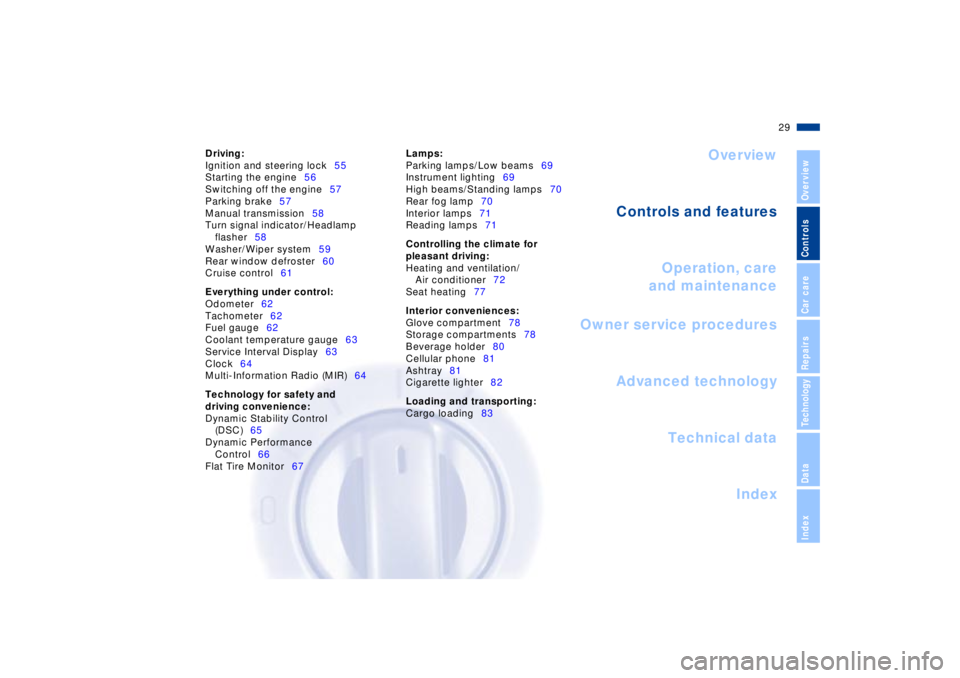
Overview
Controls and features
Operation, care
and maintenance
Owner service procedures
Technical data
Index Advanced technology
29n
IndexDataTechnologyRepairsCar careControlsOverview
Driving:
Ignition and steering lock55
Starting the engine56
Switching off the engine57
Parking brake57
Manual transmission58
Turn signal indicator/Headlamp
flasher58
Washer/Wiper system59
Rear window defroster60
Cruise control61
Everything under control:
Odometer62
Tachometer62
Fuel gauge62
Coolant temperature gauge63
Service Interval Display63
Clock64
Multi-Information Radio (MIR)64
Technology for safety and
driving convenience:
Dynamic Stability Control
(DSC)65
Dynamic Performance
Control66
Flat Tire Monitor67Lamps:
Parking lamps/Low beams69
Instrument lighting69
High beams/Standing lamps70
Rear fog lamp70
Interior lamps71
Reading lamps71
Controlling the climate for
pleasant driving:
Heating and ventilation/
Air conditioner72
Seat heating77
Interior conveniences:
Glove compartment78
Storage compartments78
Beverage holder80
Cellular phone81
Ashtray81
Cigarette lighter82
Loading and transporting:
Cargo loading83
Page 30 of 174
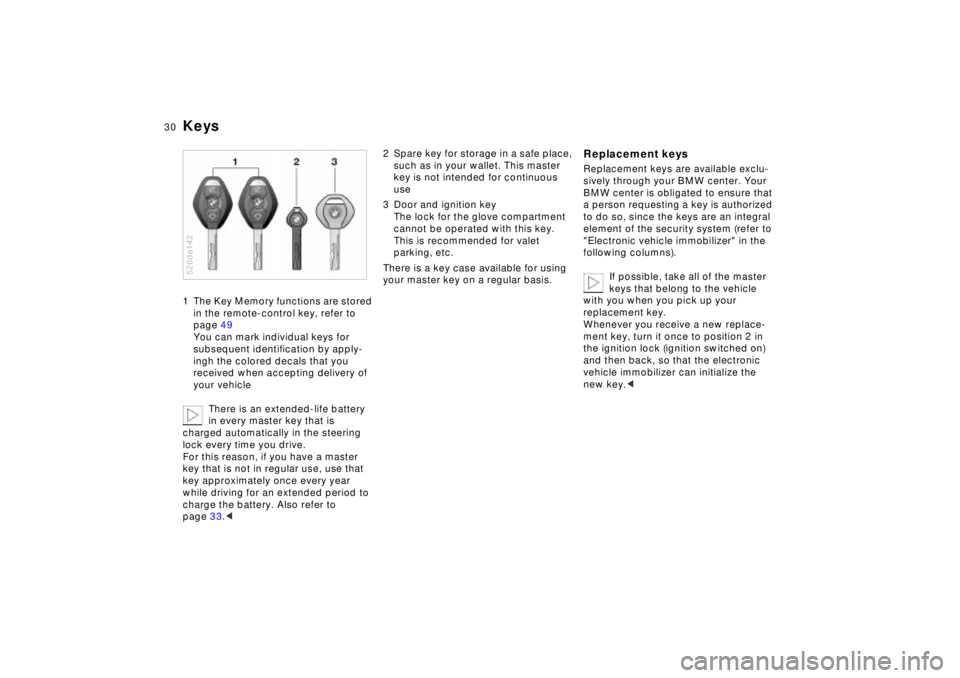
30n
Keys1 The Key Memory functions are stored
in the remote-control key, refer to
page 49
You can mark individual keys for
subsequent identification by apply-
ingh the colored decals that you
received when accepting delivery of
your vehicle
There is an extended-life battery
in every master key that is
charged automatically in the steering
lock every time you drive.
For this reason, if you have a master
key that is not in regular use, use that
key approximately once every year
while driving for an extended period to
charge the battery. Also refer to
page 33.< 520de142
2 Spare key for storage in a safe place,
such as in your wallet. This master
key is not intended for continuous
use
3 Door and ignition key
The lock for the glove compartment
cannot be operated with this key.
This is recommended for valet
parking, etc.
There is a key case available for using
your master key on a regular basis.
Replacement keysReplacement keys are available exclu-
sively through your BMW center. Your
BMW center is obligated to ensure that
a person requesting a key is authorized
to do so, since the keys are an integral
element of the security system (refer to
"Electronic vehicle immobilizer" in the
following columns).
If possible, take all of the master
keys that belong to the vehicle
with you when you pick up your
replacement key.
Whenever you receive a new replace-
ment key, turn it once to position 2 in
the ignition lock (ignition switched on)
and then back, so that the electronic
vehicle immobilizer can initialize the
new key.<
Page 31 of 174
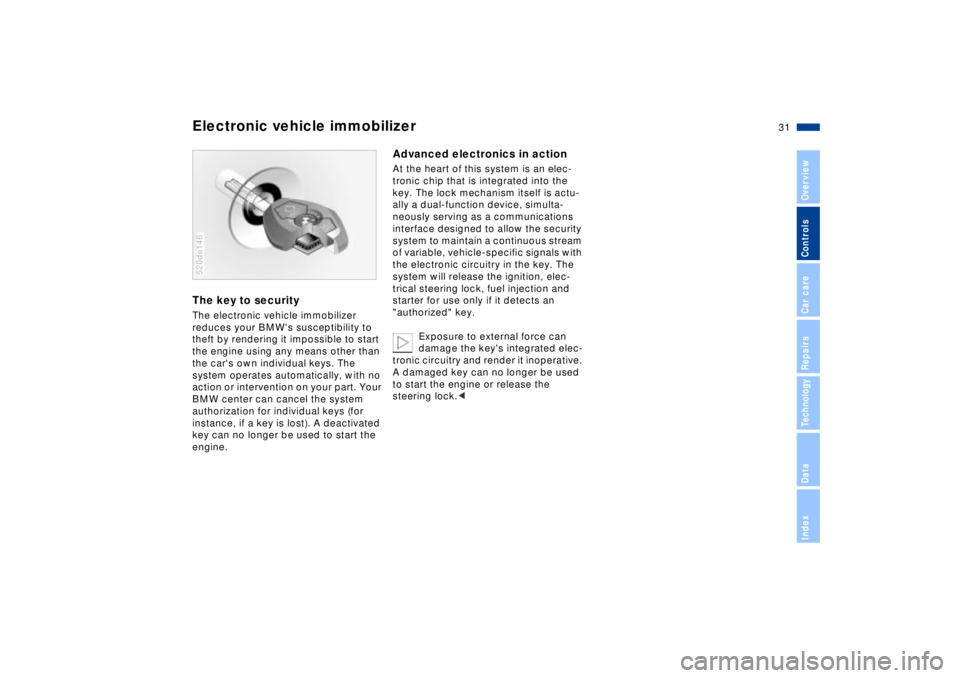
31n
IndexDataTechnologyRepairsCar careControlsOverview
Electronic vehicle immobilizer The key to securityThe electronic vehicle immobilizer
reduces your BMW's susceptibility to
theft by rendering it impossible to start
the engine using any means other than
the car's own individual keys. The
system operates automatically, with no
action or intervention on your part. Your
BMW center can cancel the system
authorization for individual keys (for
instance, if a key is lost). A deactivated
key can no longer be used to start the
engine.520de146
Advanced electronics in actionAt the heart of this system is an elec-
tronic chip that is integrated into the
key. The lock mechanism itself is actu-
ally a dual-function device, simulta-
neously serving as a communications
interface designed to allow the security
system to maintain a continuous stream
of variable, vehicle-specific signals with
the electronic circuitry in the key. The
system will release the ignition, elec-
trical steering lock, fuel injection and
starter for use only if it detects an
"authorized" key.
Exposure to external force can
damage the key's integrated elec-
tronic circuitry and render it inoperative.
A damaged key can no longer be used
to start the engine or release the
steering lock.<